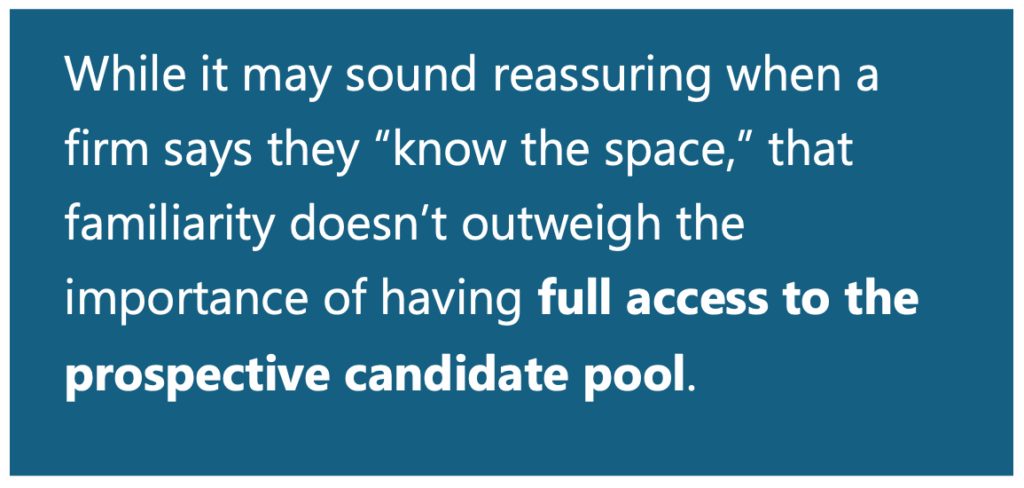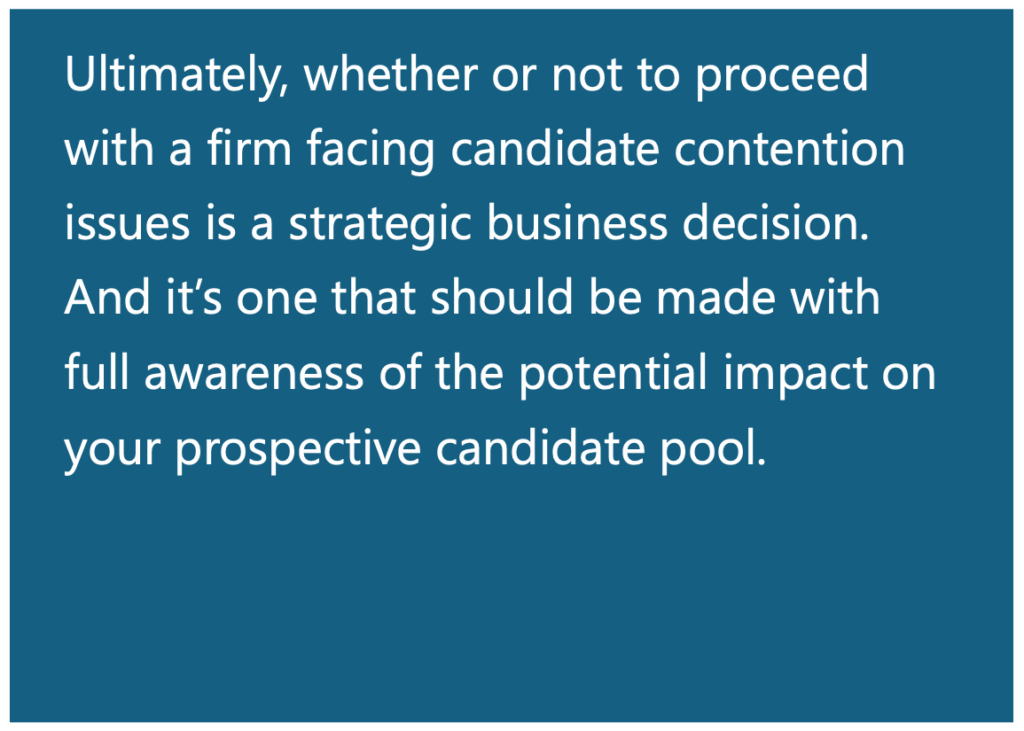 Whether you’re a seasoned EVP of Talent Acquisition at a Fortune 50 company or a CEO piloting your first retained search, understanding candidate contention within a search firm can make the difference between a successful hire and a disappointing outcome. Candidate contention—where multiple searches target the same limited pool of candidates—is a challenge that spans firms of all sizes. It’s not exclusive to global giants; boutique firms, regional specialists, and niche firms focused on roles like CFO, CIO, CHRO etc., are all susceptible.
Whether you’re a seasoned EVP of Talent Acquisition at a Fortune 50 company or a CEO piloting your first retained search, understanding candidate contention within a search firm can make the difference between a successful hire and a disappointing outcome. Candidate contention—where multiple searches target the same limited pool of candidates—is a challenge that spans firms of all sizes. It’s not exclusive to global giants; boutique firms, regional specialists, and niche firms focused on roles like CFO, CIO, CHRO etc., are all susceptible.
This article doesn’t criticize any particular firm’s size or type. Instead, it sheds light on the broader issue of overlapping searches and how they can impact your ability to access the most qualified executive talent.
What Is Candidate Contention?
In retained executive search, candidate contention occurs when multiple clients of the same firm are conducting similar searches that target overlapping pools of candidates. This internal competition limits which potential candidates a consultant can ethically approach—even if those individuals aren’t restricted by client-imposed off-limits agreements.
Why Is It a Problem?
A retained search firm is ethically bound to present a candidate to only one client at a time. If the firm is managing multiple similar searches, a candidate cannot be actively approached for more than one opportunity concurrently. Presenting the same candidate to multiple clients simultaneously would violate the trust and fiduciary responsibility each search partner holds toward their client.
 Unless a candidate has been formally rejected or passed over, they remain tied to the original search. Given the limited pool of qualified executives at the CXO or VP level, search partners are understandably cautious about releasing strong prospects. They will typically exhaust all efforts to engage, evaluate, and recruit a prospective candidate for their current assignment before releasing them for another. This practice, while ethical, can significantly reduce the number of viable candidates available to you as a client.
Unless a candidate has been formally rejected or passed over, they remain tied to the original search. Given the limited pool of qualified executives at the CXO or VP level, search partners are understandably cautious about releasing strong prospects. They will typically exhaust all efforts to engage, evaluate, and recruit a prospective candidate for their current assignment before releasing them for another. This practice, while ethical, can significantly reduce the number of viable candidates available to you as a client.
How Limited Are Senior-Level Candidate Pools?
Senior-level candidate pools are inherently narrow. Once you exclude frequent job-changers, individuals new to leadership roles with limited experience, or those who don’t meet specific “must-have” criteria, the pool of viable candidates shrinks quickly. For most executive searches, the targeted pool typically falls within the 70 to 90 prospective candidate range.
In my experience across ten recent VP and CXO-level searches:
- The smallest pool included 57 candidates
- The largest reached 172, due to a strategic shift mid-search
- Remote-friendly roles consistently yielded larger candidate pools than those requiring on-site presence
Crucially, none of these searches were impacted by off-limits restrictions or candidate contention. That freedom enabled a broader, more competitive slate of candidates—something that can be significantly compromised when internal limitations from candidate contention exist within a search firm.
What Does This Mean for Clients?
If your search firm is conducting similar searches concurrently, your access to top candidates may be significantly limited. You could end up with:
- Only 30–40 truly viable prospects
- Candidates included to “pad” the list—individuals who wouldn’t normally be considered for the role
- Little to no access to top-tier executives already engaged in other searches
While it may sound reassuring when a firm says they “know the space,” that familiarity doesn’t outweigh the importance of having full access to the candidate pool. In executive search, breadth and depth of access often determine the quality of the final slate.
Navigating the Pitfalls of Candidate Contention with Your Search Partner
Let’s assume your search partner is competent, honest, and genuinely prioritizes your interests. At the same time, they are responsible for generating revenue for their firm—which includes bringing in new search assignments. Their compensation is often directly tied to the revenue generated from those engagements, so it’s natural they’ll want to take on new opportunities.
This is where the responsibility shifts to you, the client. It’s your role to qualify the firm for the specific assignment at hand. Whether you’re working with a long-standing partner or engaging a retained search firm for the first time, these principles apply.
In fact, organizations with long-term agreements may be more inclined to hand over a search without closely examining issues like candidate contention or off-limits restrictions—both of which are fluid and can change rapidly. Taking the time to assess these factors upfront can make a significant difference in the outcome of your search
Key Questions to Ask Your Search Firm
To protect the integrity of your search, ask your search firm these key questions:
 Are you currently conducting similar searches in my industry or adjacent segments?
Are you currently conducting similar searches in my industry or adjacent segments?
If the answer is yes, candidate contention is likely and should be explored further.- How many similar searches are active, and what stages are they in?
If your search partner doesn’t have this information readily available, ask them to follow up with specifics. If multiple searches are in early or mid-stages, it may be worth reconsidering whether this firm is the best fit for your assignment. - How does your firm manage internal candidate contention?
Understanding their approach will help you evaluate whether they can effectively navigate overlapping searches without limiting your access to top talent. - How will you ensure broad access to the full candidate pool for this specific assignment?
Ask for detailed, search-specific strategies—not generalities—to understand how they’ll overcome any limitations.
Let your search partner know you’re aware of the impact candidate contention can have—and that it may influence your decision on which firm to engage for the assignment.
What You’ll Likely Hear
When discussing candidate contention, here’s what you’ll likely hear from your search firm:
- They’ll explain how they manage overlapping searches and coordinate internally to avoid conflicts.
- They may emphasize that they “know the space” and are familiar with all the key players.
- Long-standing partners will highlight their deep understanding of your company and the strong relationships they’ve built with your executive team.
While these are all valid points, none of them address the core issue: limited access to potential candidates due to internal candidate contention. Familiarity with the market and your organization is valuable—but it doesn’t compensate for a restricted candidate pool.
Final Thoughts
Your goal is to recruit the best executive for the role. While candidate contention isn’t present in every search, when it is, understanding its scope is critical—it can directly compromise the success of a retained search.
Ultimately, whether or not to proceed with a firm facing candidate contention issues is a strategic business decision. And it’s one that should be made with full awareness of the potential impact on your prospective candidate pool.
Remember, the best executives are often evaluating multiple opportunities. You know this—because you’ve been in their position. Executive recruiting is highly competitive. Most of the time, you’re up against other candidate opportunities you can’t control, while also trying to dislodge a qualified prospect from a company where they may still see growth potential.
Consider the personal variables that are beyond your control—relocation challenges, children in high school, a spouse with their own career. These factors can significantly influence a candidate’s decision, yet they’re outside your sphere of influence.
What you can control is candidate contention. You choose which search firm is best positioned to take on the assignment. With so many uncontrollable elements in play, don’t let internal candidate contention within a search firm limit your access to top talent from the outset.
